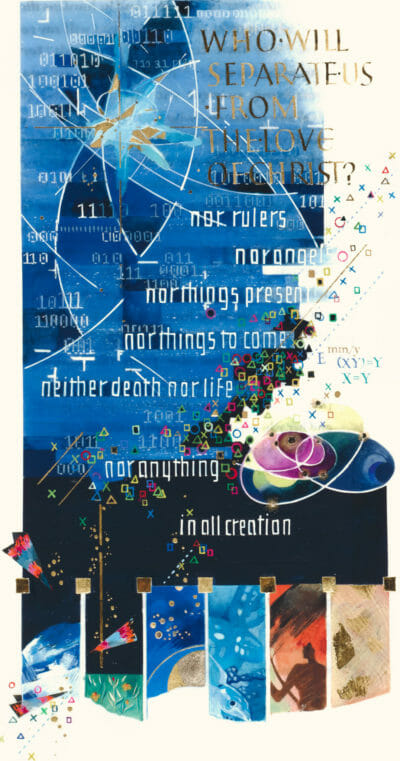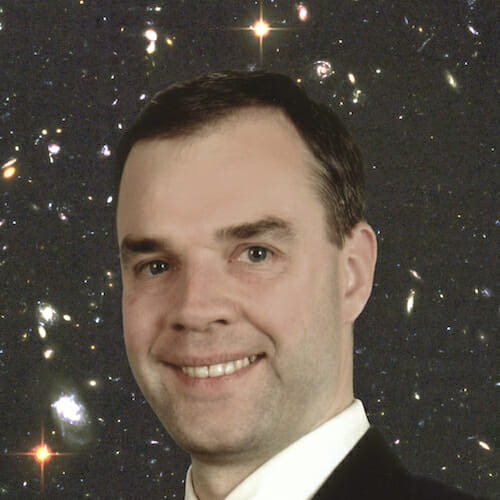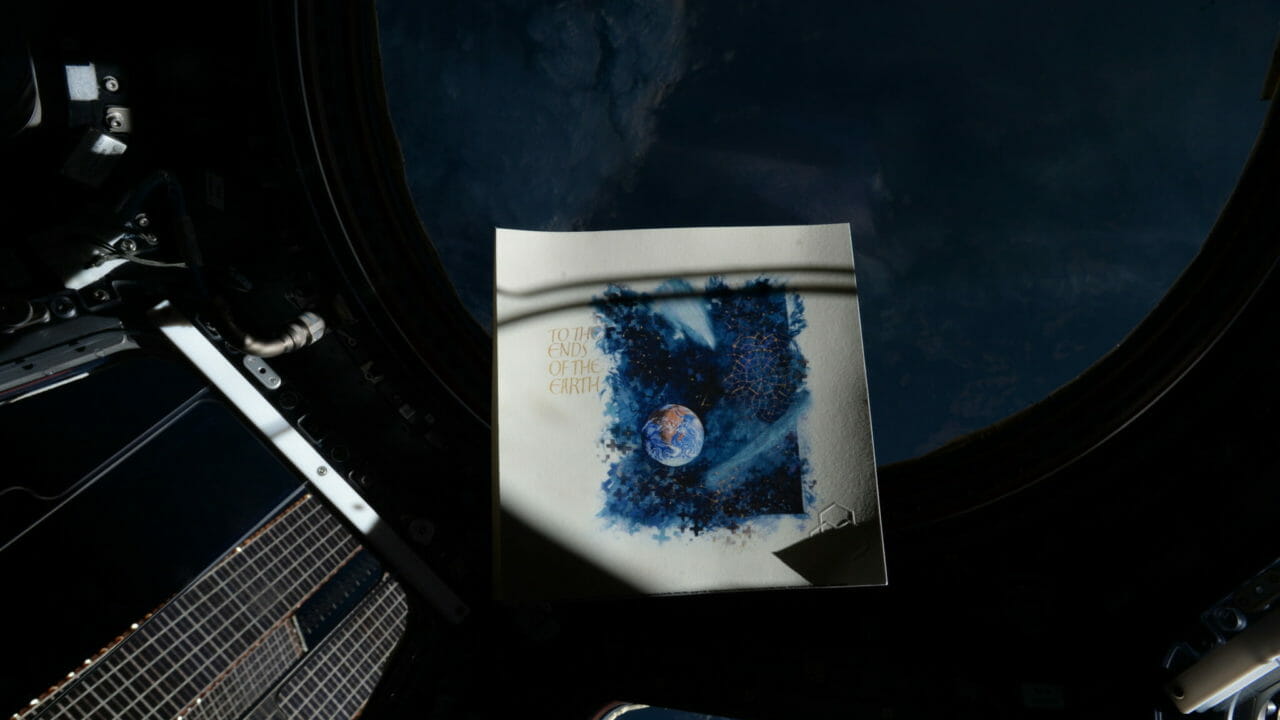An Astrophysicist Sees “Science & Faith in Harmony” within The Saint John’s Bible
Dr. Anton Koekemoer’s lecture asks audiences to “contemplate the grand scale of the universe”
The Saint John’s Bible has inspired people from all walks of life, but among those who lecture on the Bible or are involved with it professionally, there tend to be a few common themes—religious leaders, calligraphers, and academics, primarily in the liberal arts. But as a growing number of audience members have learned over the past several years, one especially fascinating figure with a unique point of view on The Saint John’s Bible comes from a rather unexpected background: astrophysics.
 That expert is Anton Koekemoer, Ph.D., a research astrophysicist with the Hubble Space Telescope at the Space Telescope Science Institute. When the Hubble telescope isn’t occupying Dr. Koekemoer, he also spends his personal time presenting his lecture, “Science & Faith in Harmony: Cosmology and The Saint John’s Bible.”
That expert is Anton Koekemoer, Ph.D., a research astrophysicist with the Hubble Space Telescope at the Space Telescope Science Institute. When the Hubble telescope isn’t occupying Dr. Koekemoer, he also spends his personal time presenting his lecture, “Science & Faith in Harmony: Cosmology and The Saint John’s Bible.”
“The overall theme of my presentation is to convey a sense of awe and wonder about our amazing universe, to show that this can be appreciated equally from both scientific and religious perspectives,” writes Dr. Koekemoer. “From nearby planets and beautiful glowing clouds of interstellar gas, to majestic star clusters, countless galaxies, and the most distant objects in the universe discovered in our deepest images, the presentation forms a journey of exploration through the cosmos, including images from the Hubble Space Telescope that inspired some of the beautiful illuminations in The Saint John’s Bible.”
Reconciling Science and Faith
While the image of the atheist scientist is by now a caricature in popular media, Dr. Koekemoer explains that he sees no conflict between his Christian faith and his professional calling. He writes, “It can be helpful to think of science as focusing on discovering the physical mechanisms at work in the universe, in terms of developing mathematical descriptions and principles that describe what we observe. So, questions related to the physical processes observed in the universe are readily addressed by science; on the other hand, however, questions related to the purpose or meaning of our existence, or similar topics that are more related to faith, are not necessarily described in a scientific context, and can rather be considered from the perspective of religion.”
Dr. Koekemoer points to the illuminations of The Saint John’s Bible as illustrations of this relationship between faith and reason. “Consider how some of the Hubble images have been woven into the artistic themes, such as the illuminations depicting the narratives in Genesis,” he writes. He states that this imagery “forms a powerful visual representation of God’s role as creator, and complements our scientific endeavors to unveil the physical processes of stars, galaxies, and the universe overall.”
Dr. Koekemoer’s dual perspective on faith and reason has drawn audience members from many different backgrounds to his lectures, and he notes that “it is wonderful to see audiences welcome the overall theme of reconciling science with religion, in terms of contemplating the grand scale of the universe from the perspective of various different individual levels of faith.”
Awe and Wonder at the Universe
 While astrophysicists may have more day-to-day reasons for asking the big questions about our world, Dr. Koekemoer points out that the cosmos can offer a path toward deep reflection for us all. “Contemplating the grand scale of the universe, and the beauty revealed in all our astronomical images, can leave anyone with a profound sense of awe and wonder, regardless of one’s perspective on religion,” he says. “It can also lead us to ponder the overall significance of our own humanity by comparison, as stated eloquently by the Psalmist: ‘what are human beings, that You are mindful of them?’ (Ps. 8:4), while the very next verses, and much of the rest of scripture, address these questions and show how precious we all are to God. Thus, when we consider the universe from the viewpoint of religion, contemplating God as its creator, faith can be deeply enriched as a result.”
While astrophysicists may have more day-to-day reasons for asking the big questions about our world, Dr. Koekemoer points out that the cosmos can offer a path toward deep reflection for us all. “Contemplating the grand scale of the universe, and the beauty revealed in all our astronomical images, can leave anyone with a profound sense of awe and wonder, regardless of one’s perspective on religion,” he says. “It can also lead us to ponder the overall significance of our own humanity by comparison, as stated eloquently by the Psalmist: ‘what are human beings, that You are mindful of them?’ (Ps. 8:4), while the very next verses, and much of the rest of scripture, address these questions and show how precious we all are to God. Thus, when we consider the universe from the viewpoint of religion, contemplating God as its creator, faith can be deeply enriched as a result.”
As human knowledge marches forward, Dr. Koekemoer writes that he is hopeful that science, philosophy and religion “can be considered in relationship to each other, and can interact in positive ways at many levels, leading to deeper growth.
“We are at a very exciting time in astronomy,” he says, “with new projects planned for current and future telescopes and observatories that will probe the first generations of stars and galaxies to have formed at the earliest cosmic times, as well as other projects that continue to discover thousands of planets beyond our solar system. I’m eagerly looking forward to these and other discoveries, both as a research astronomer interested in new scientific advances, and as a Christian in terms of enriching my faith, through a deeper sense of awe and wonder at the universe.”
Disclaimer: Dr. Koekemoer’s views expressed here are strictly from a personal perspective and are not intended in any way to necessarily represent those of, or be endorsed by, any other entity or organization.
Illuminations featured in this article:
- To the Ends of the Earth, Donald Jackson with contributions from Andrew Jamieson and Sally Mae Joseph, Copyright 2002, The Saint John’s Bible, Saint John’s University, Collegeville, Minnesota USA.
- Fulfillment of Creation, Thomas Ingmire, Copyright 2011, The Saint John’s Bible, Saint John’s University, Collegeville, Minnesota USA.


